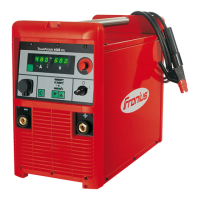3
EN
General remarks
The TP 1500 power source is a further
member of the new generation of welding
rectifiers. High-performance electronics
have helped create a truly unique rectifier
that weighs in at a mere 4.7 kg.
The TP 1500 works on the principle of the
resonance inverter. The voltage from the
mains is first rectified. The resulting DC
voltage is then inverted, at a frequency of
up to 150 kHz. The welding transformer
then creates the required operating
voltage, which is rectified and delivered to
the output sockets.
Principle of the
TP 1500
Fig.1 TransPocket 1500 welding unit
In the further development work done on the inverter principle in the direction of a
resonance inverter for the TP 1500 power source, wholly new approaches have been
taken. Instead of a simple transistor switch or pulse-width modulation, the principle of a
resonance converter is used for generating the high-frequency primary voltage.
In spite of the complicated controlling system needed for use in welding, the resonance
converter principle offers a number of useful advantages:
- The resonance structure makes it possible to achieve a nearly "ideal output characte-
ristic"
- Reduced switching losses permit higher switching frequencies yet with optimum
efficiency
- Superb ignition and welding properties, yet lowest possible weight and very compact
dimensions
An electronic controller adjusts the power-source characteristic to the electrode that is
to be welded. When cellulose (CEL) electrodes are used, a special operating mode can
be selected for this, ensuring perfect welding results.
Its range of use and application is considerably extended by the facility for TIG welding
with touch-down ignition.
